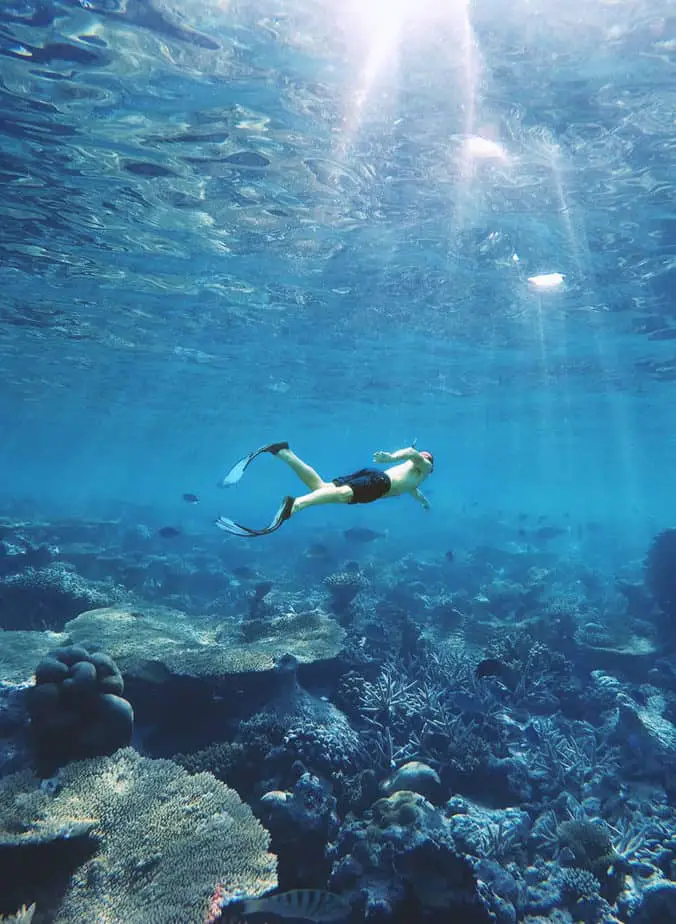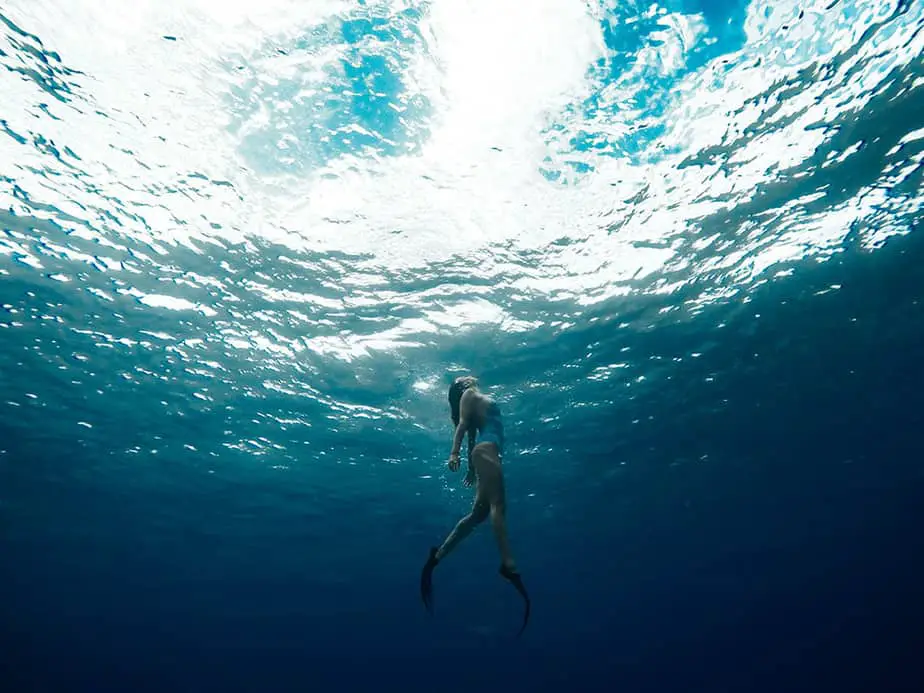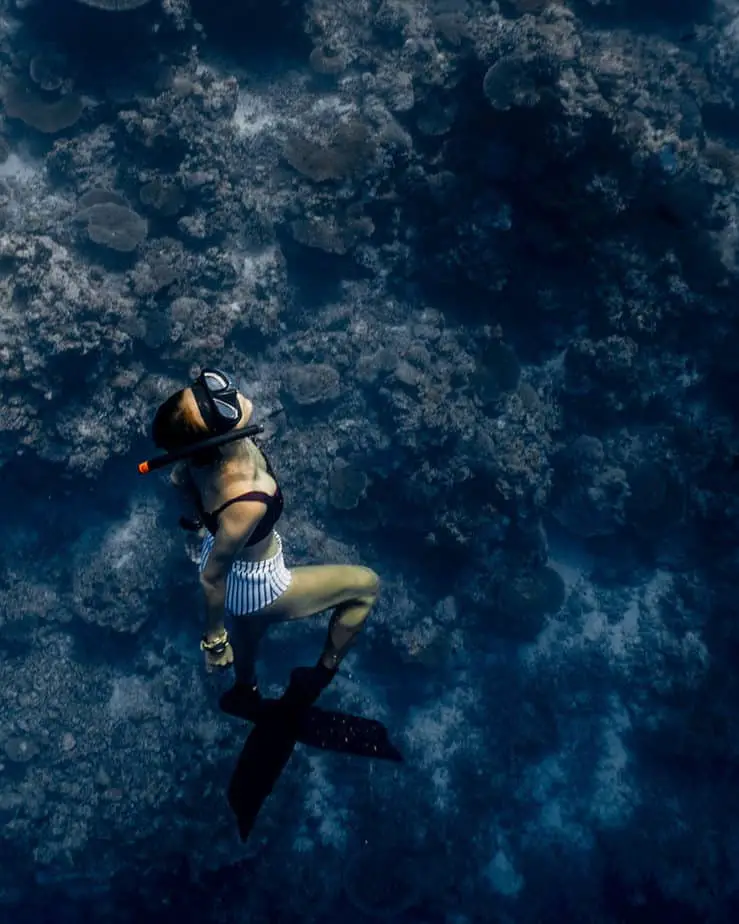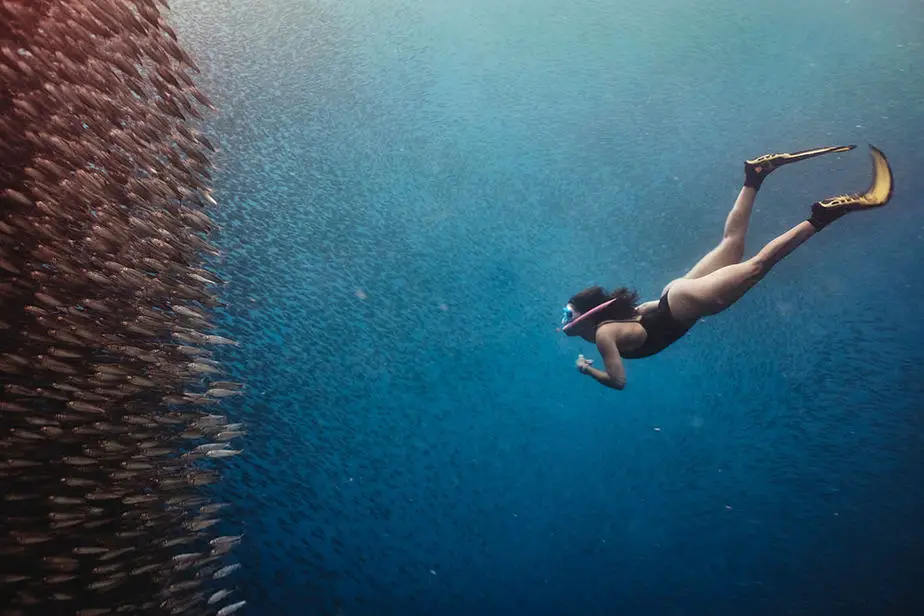How deep can you snorkel underwater if you used a really long snorkel tube? Can you stay underwater for as long as a SCUBA diver by breathing through a long snorkel instead of using SCUBA equipment? Unfortunately, trying to breathe underwater with a snorkel doesn’t work very well except by the water’s surface. The deepest you can snorkel is around 1.5 to 2 feet deep before it becomes impossible.
There’s a reason why most snorkels are only about 12-15 inches long. That’s because any longer than that and you start running into some major problems. First, there is the obvious fact that a long tube is impractical since it could easily break or snag on something in the water. Second, there’s also the problem of water pressure making it difficult to inhale air from the surface.
At around 1.5 feet deep (18 inches) it will start to feel like you are sucking air through a clogged tube. Third, there’s also the issue of stale air. Each time you exhale, you are releasing carbon dioxide that may not fully clear out of the tube. Over time, the CO2 will build up so each time you inhale you are getting less fresh oxygen and more CO2. At some point it will feel like you’re asphyxiating (because you actually are) even though you’re still breathing.
In other words, trying to snorkel at depths below the surface isn’t practical. Instead, you should be learning how to hold your breath and diving down to get a closer look at the underwater sights.
How to Maximize Your Snorkeling Experience
Rather than trying to snorkel deep underwater, you should either learn how to SCUBA dive or practice how to duck dive while snorkeling. Duck diving is the skill of holding your breath and swimming underwater for a short period of time. Instead of being a passive observer while snorkeling, experienced snorkelers will dive down to get a closer look at whatever interests them.
You don’t need to be able to breathe underwater to get the most out of your snorkeling trip! Learn how to improve your duck diving technique instead and explore where you want to go underwater without holding back. For the rest of this article, we’ll be going over tips to help you dive deeper underwater while snorkeling. We’ll go over breath holding and duck diving basics, dangers to avoid underwater, and how to overcome your fear of diving so that you can dive safely while snorkeling.
Duck Diving Common Dangers
Duck diving refers to relatively shallow diving (~10-15m) and is considered to be quite safe. On the other hand, free diving is when a diver tries to dive down as far as they can go before resurfacing, all in one breath.
It is significantly more dangerous than duck diving and is done by professionals in competitions. Whether you are duck diving or free diving, there is a very real possibility of drowning if you are an inexperienced diver.
Panic
While it’s not too difficult to reach a depth of 10 meters, beginners may feel a sudden urge to breathe and panic when they realize they didn’t account for the trip back to the surface. That is why it is imperative to stay calm in order to conserve energy and to be in the right state of mind. Panic will cause you to thrash around and waste precious oxygen and energy when you should be moving calmly and slowly.
Ear Barotrauma
You must frequently equalize your ears as you dive down. Otherwise, you can experience a pressure related injury known as middle ear barotrauma. Every few meters, you will feel pressure in your ears that can get quite painful unless you ‘clear’ it out. To do so, pinch your nose and try to exhale through your pinched nose. You should feel the pressure in your ears release.
If you are not able to clear your ears while underwater, resurface and clear your ears there. Do not be forceful with equalization, as you can easily blow out your eardrum which can happen if they are soggy. It would also be extremely painful, so it’s not a mistake you ever want to experience or repeat. Some divers are able to withstand the pressure, however it is recommended to equalize your ears every few meters.
Shallow Water Blackouts
If you dive too quickly with little to no rest intervals between each dive, then you can potentially experience shallow water blackout. The general rule of thumb is that your rest intervals should be twice as long as the time you spent diving underwater. So if you duck dived for one minute, you should rest at least two minutes before attempting it again. If you blackout underwater, you will certainly drown unless you have a buddy with you.
Boats
Another reason you should not panic and surface too quickly is that you need to make sure there are no boats passing overhead. You can use a dive flag to mark where you are so other snorkelers and boats know you are underwater.
If you don’t have a dive flag, then you need to at least do a cursory glance of the surrounding area before surfacing. It is best to snorkel and duck dive in areas where there are no boats around so that there is one less danger to worry about.
Ego
Do not let your ego get the best of you. Try to stay within your limits and realize that you need to don’t push yourself to break a new personal best every dive. Always remember that the deeper you dive the longer it takes to resurface and factor that in when trying to set a new personal best.

Basic Breath-Holding Techniques
Before even learning about how to duck dive, you need to know how to hold your breath underwater. You must know how your body reacts when it is deprived of oxygen. This can be done safely in a controlled environment, such as the shallow end of the pool or even on dry land. We recommend doing it in the water for a more authentic experience. Keep a stopwatch with you and try these exercises.
Holding Your Breath
Hold your breath underwater for as long as you can so that we can gauge your level. A good goal to aim for is 60 seconds, or one minute. However, expect your first attempt to be somewhere between 20-40 seconds. The average person takes a breath once every three seconds, so you have missed out on 7 to 13 breaths. That’s really good! You will be able to improve that with practice.
Repeat step 1 after resting for at least 1-2 minutes. You will find that your second attempt will be better than your first. And that your third attempt will be slightly better than your second. This is because your body is acclimatizing to what you’re doing, as if you are warming up before performing a workout. Before attempting a deep dive, first do this “warm up” process to get your body ready.
Breath-Holding Exercise #1
Now that your body is primed, you can do this technique to improve your breath holds even further. Before diving, do the following:
- Take five deep breaths.
- For each breath, hold it for 3 seconds before exhaling. This helps you store more oxygen into the circulating blood and is what will feed into your large muscles.
- Try holding your breath for as long as you can.
Whereas you might have only lasted 20-40 seconds before, after doing this technique you will most likely double your breath hold time. That is a massive improvement. You can try this technique again to see if your times improve even further.
How Does this Work?
The reason why the above technique works is that you are putting the oxygen in your body where it matters the most. Believe it or not, the oxygen in your lungs is used up after 6 seconds. That means that the majority of the oxygen your body is using comes from the blood, which can last about a minute, and finally the large muscles in your body.
If you find yourself suddenly feeling lightheaded, you have crossed the threshold and you are now at the danger point. Don’t allow yourself to reach this point, and if you do, surface as fast as you can while remaining as calm as possible.
Measuring Your Heart Rate
Next, you need to measure your heart rate. Place your middle and index fingers on your neck and feel for a pulse. Once you’ve found it, count how many pulses occurred in 6 seconds. Then multiply that number by 10 to get your BPM.
While stationary, your heart rate is probably around 60, or one pulse every second. Doing even the lightest physical activity can nearly double that number. The fitter you are, the lower the BPM will be. Snorkel divers should aim to have a BPM lower than 110 while diving, otherwise they will not be able to hold their breath for very long.Basic Diving Techniques

Swimming Underwater
When you are moving around, your oxygen consumption will increase drastically. The best snorkel divers have learned to swim underwater efficiently, meaning they can swim farther with as little effort as possible. Each exertion consumes oxygen, and someone madly flailing around will not last for long.
Conserving Oxygen
If you can keep calm and relax underwater, you are starting off on the right foot. Both of these qualities means your heart rate will be as low as possible, allowing you to conserve oxygen for longer.
Your muscles can do a small amount of work (anaerobic) without using oxygen as energy. To put it simply, it has its own energy reservoir. This reservoir must be replenished each time you surface, which is why it is recommended you should rest for twice as long as you just dove for. Fit individuals can recover much faster than unfit divers, and smokers will take the longest.
Thus, how fit or unfit someone is has nothing to do with how far they can dive, but rather how quickly they can recover before attempting the next dive. Your vacation time is limited, so being a fit diver means you can dive and explore more than if you were unfit.
Swimming Efficiently
While your muscles are still using up its anaerobic energy, it is advantageous for you to utilize as many muscle groups initially (arms and legs) to pull yourself deep underwater. After that initial boost, it’s time to tone it down by using your legs only.
The majority of the swimming is done with your legs. Try to perform slow and controlled ‘lazy’ kicks. Take note of how the water flows around you and move with it. Check if your body is balanced horizontally so you can explore quickly.
Once you dived down to the depth that you want, let out some air to decrease your buoyancy. Otherwise, the entire time you will be spending some energy swimming downwards rather than swimming horizontally and exploring.
In order to cover the most distance with minimal effort, you should be wearing short snorkeling fins. With fins on, each kick you make will generate more thrust, propelling you much farther than without them.
If you are not a strong swimmer, you should read our guide on snorkeling and swimming tips for beginners.
Diving With A Snorkel – Is It Possible?
If you are just a casual snorkeler, there is no reason to go beyond 10-15m, which is also the depth that most underwater cameras for snorkeling can operate at without a housing case. With some additional training and practice, you might be able to push 25-30m. At this point you are not diving to see the underwater sights, instead you are aiming to set a new personal best.
To go even further down you would need to be an experienced diver using an anchor rope. Most people will never reach this level unless they participate in free diving competitions. How deep one can dive underwater is dependent on how long they can hold their breath.
If you black out underwater, you are almost certainly going to drown. That is why if you are a casual snorkeler, stay within 10-15m and surface before you feel lightheaded. Most people will naturally get the urge to breathe and surface on time. However, there is a technique known as hyperventilating that can suppress one’s urge to breathe by clearing the carbon dioxide from their blood.
This is a risky technique since it delays the brain’s natural response to breathe. Divers may run out of oxygen, causing their brain to shut down and lose consciousness. After that, it’s game over. That is why you should always listen to all the signals your body is sending you: cramps, headaches, fatigue, dizziness, nausea, snot, and so on. Don’t push yourself too hard and stay within your limits.
Lastly, don’t feel bad if your first few dives of the day are awful. No, you didn’t suddenly lose the progress you made from last time. Even experienced snorkelers will find that they need a few practice dips before their body adjusts to the activity. Try diving down at least 15 times to get yourself ready for the real dive.

Common Diving Fears
One of the most important things you must do when diving is to stay calm. However, your natural fears may prevent you from diving to your full potential. Even a slight increase in your heart rate will make it harder to hold your breath. As such, you must overcome your fears, whether they are irrational or not. Here are some common fears people have, and why they shouldn’t be scared of them.
Sharks
Even though we all know Jaws isn’t real, it helped to propagate this idea that sharks are man-eating monsters that are actively searching for their next prey. That couldn’t be further from the truth. First of all, it is rare to even see a shark in the ocean. And even if you do see one while diving, have some peace of mind knowing that humans are not their prey.
To them, you are an unknown creature they have never seen before. They will be cautious and perhaps even scared of you. Take a look at all cases of shark attacks and you’ll find that sharks never ate their victims. If they ever took a bite at someone, it is because they mistook them for their normal prey, and they swam off once they realized they bit the wrong thing.
If you ever meet a shark, do not panic as this can cause you to drown. Make sure you do not have an injury that is bleeding, as the blood can attract them. Otherwise, they will leave you well alone and will probably even swim away from you if you approach them.
Other Sea Creatures
Depending on where you are snorkeling and diving, you may encounter poisonous snakes and fishes. Like sharks, they are cautious of you and will probably swim away. These animals already know what is considered their prey, and humans are not one of them.
However, to be safe you may want to wear a full wetsuit or rashie to cover any exposed skin. This can protect you from jellyfish stings which can paralyze your muscles. If you are wearing a wetsuit while diving, you may need to wear some dive weights to counteract the buoyancy the suit provides.
Tangled in Seaweed
You might be afraid of getting caught in seaweed and drowning. However, the reality is that seaweeds tend to slip off due to how slimy they are. Getting tangled in them is very unlikely and if there was a possibility of entanglement, the seabed would have to be such an overgrown mess of tangled and knotted seaweeds that you wouldn’t even want to enter the water.
Fear of Drowning/Lack of Oxygen
Not being able to take a breath when you want to is scary. As soon as your airflow is restricted, you may feel a sense of foreboding and your fear of drowning kicks in, elevating your heart rate. Successful diving requires you to be in a zen, almost meditative state of mind.
Before you reach that level, you must practice in shallow depths until you overcome your fears. As you improve, so will your confidence and your anxiety will slowly dissipate. Just make sure not to let your ego get in the way when trying to set a new dive record.
How Deep Can You Snorkel – Verdict
If you are wondering how deep you can snorkel using a long tube, the answer is not very deep – 1.5 to 2 feet at most. Our lungs are not very good at sucking in air, and the more distance the air has to travel, the harder it is for lungs to inhale it. Furthermore, when exhaling the air, much of the carbon dioxide will stay in the snorkel and get re-inhaled. Eventually you will not receive enough oxygen and can asphyxiate.
As for how far you can dive down while snorkeling, a good depth is a few meters up to about ten meters. There is not much point going deeper than that, as most of the underwater sights and creatures can be seen at this depth. Furthermore, you would need extensive training to work on your breath holding techniques, and your risk of drowning increases the deeper you dive.

